Book Deal Announcement: “The Little Book of Satanism” by La Carmina! Ulysses / Simon & Schuster, Satanic guidebook.
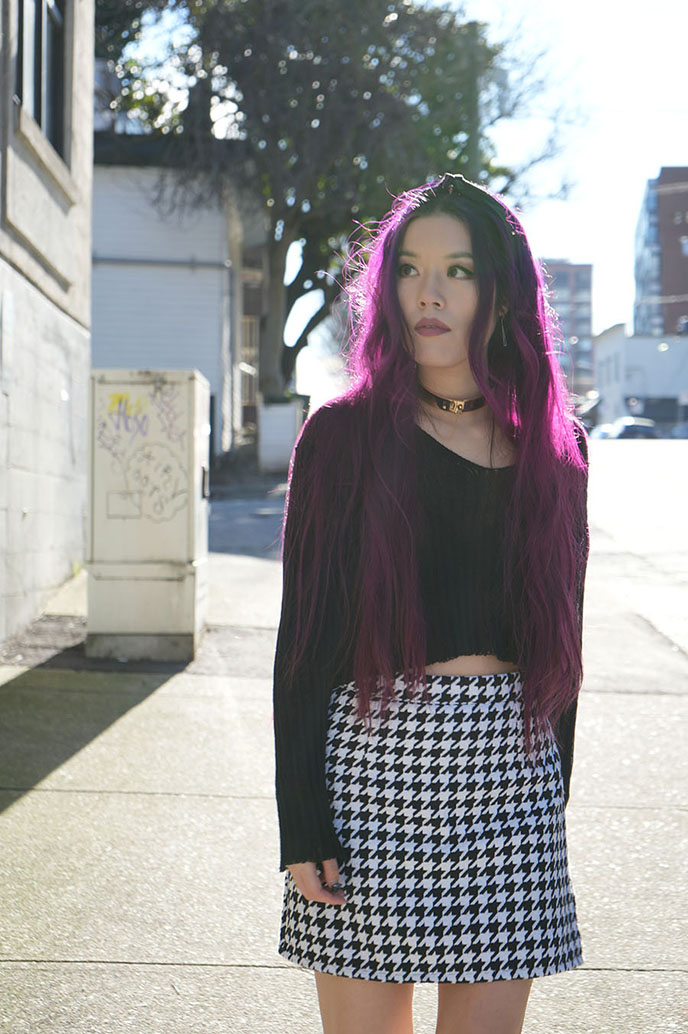
A devilish announcement: I have a new book coming out… about SATANISM! It’ll be published October 25 by Ulysses Press / Simon & Schuster!
Late last year, I received a book deal for The Little Book of Satanism: a nonfiction guide to the history, culture, and practices of Satanism. It and will be released by Simon & Schuster on 10/25.
♥ PREORDER NOW — The Little Book of Satanism: A Guide to Satanic History, Culture & Wisdom is available for preordering on Amazon. My book is also available at Barnes and Noble, Bookshop, and other retailers worldwide. Canadians can find it via Chapters/Indigo or Amazon Canada.
♥ TO SUPPORT — Please keep reading to see the Baphomet cover art, contents, and more. And thank you for taking a moment to share this post on social media — I appreciate your help in getting the word out!

❤ What is the book about?
The Little Book of Satanism by La Carmina is an accessible overview of Satanic history and culture that aims to dispel misconceptions about modern Satanists. The book introduces the Devil’s conceptualization from his Ancient Near East predecessors to the Bible and beyond. I trace Satan’s historic footprint through the centuries (the Knights Templar, Salem Witch Trials, Hellfire clubs, Aleister Crowley), to the birth of modern Satanism (LaVey’s The Church of Satan, and TST). I also cover the meaning behind Satanic sigils, the Devil in art / literature / pop culture, Satanic rituals and holidays, the Satanic Panic, and much more. (Full details further below.)
❤ Where and when can I get your book?
The Little Book of Satanism hits bookstores on October 25, 2022 — it’ll be available worldwide in both print and digital. You can pre-order my book now from Amazon, or get it from Kindle, Barnes and Noble, Bookshop, and other retailers worldwide, such as Canada’s Chapters/Indigo or Amazon Canada.
❤ How much does it cost?
Only $10.99 US for the digital version, and $14.95 US for the paperback. My book is available internationally at the links above, and can be preordered now. (Thank you for supporting!)

❤ Can you tell me more details about the book?
The following is the catalog copy for “The Little Book of Satanism: A Guide to Satanic History, Culture, and Wisdom” – by La Carmina.
Discover the fascinating history and culture of Satanism through the ages and learn why many Satanists today stand up for free inquiry and personal liberty.
Satanism is too often misunderstood as a religion that makes blood sacrifices to an evil, horned Prince of Darkness. In reality, modern Satanists are nonviolent and nontheistic, and consider the Devil to be a meaningful metaphor for the pursuit of knowledge, reason, and justice.
The Little Book of Satanism details the “mark of the beast” in cultural and historic movements over the centuries, which have informed the sincerely held beliefs and practices of Satanists today. Written by award-winning alternative culture journalist and blogger La Carmina, this comprehensive guide includes:
♥ Information on Satan’s biblical origins, and his various names, appearances, and symbols
♥ Details on his age-old role as a scapegoat, from medieval witch trials to the 1980s Satanic Panic
♥ An overview of modern philosophy and practices
♥ Examples of the Devil’s influence on art, literature, music, and films—from Paradise Lost to Rosemary’s Baby
This accessible book explains how Satanism developed in the context of social history while debunking lurid conspiracy theories about serial killers and ritual abuse. It includes a primer on various Satanic practices such as social activism, rituals, and holidays. In the spirit of the fallen angel Lucifer, be inspired by Satanism’s affirmative values that courageously oppose arbitrary authority and champion nonconformity.

❤ Can I see the book cover design? Who made it?
Above is the cover art of The Little Book of Satanism! The execution is by the Ulysses Press design team. Thank you to my Pirate – artist Naomi Rubin – for her in-depth feedback on the cover and layout.

❤ May I take a look inside?
Here’s a sneak peek at the inner pages, which incorporate Gothic fonts and inverted pentagrams. The Little Book of Satanism is 144 pages long, and includes black and white illustrations (like Stanislas de Guaita’s goat head in an inverted pentagram).
My book is in the catalog of major publisher Simon & Schuster, which put up a La Carmina author page here.
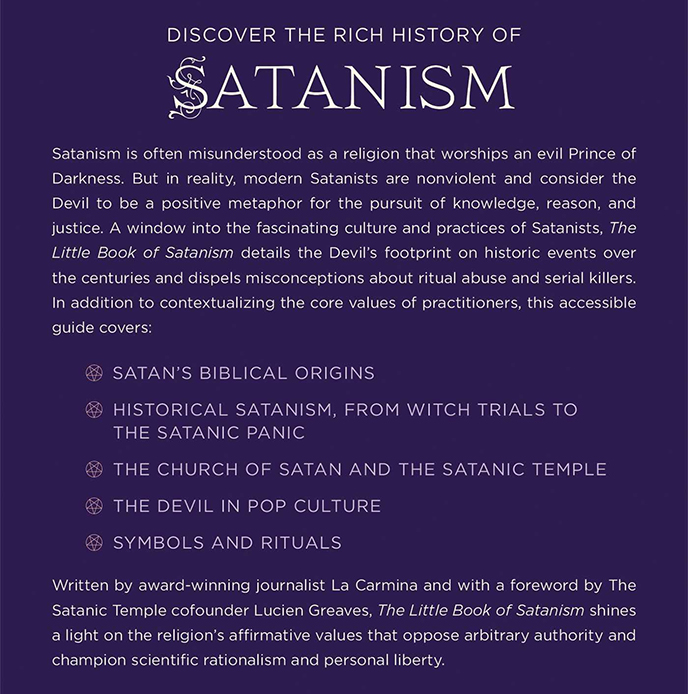
And here is the back cover copy, which invites you to discover the rich history of Satanism.
“Written by award-winning journalist La Carmina, The Little Book of Satanism shines a light on the religion’s affirmative values that oppose arbitrary authority and champion scientific rationalism and personal liberty.”
144 pages / $14.95 / Preorder via Amazon or Simon & Schuster (various links to retailers).
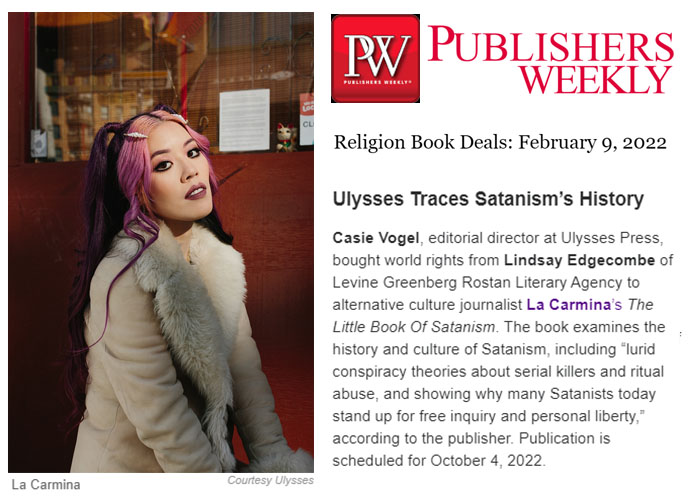
My book deal was announced in Publisher’s Marketplace and Publisher’s Weekly book deals announcements, in the Religion section. Thank you to my literary agent and to the Ulysses team for making this project possible. The article says:
“Ulysses Traces Satanism’s History. Casie Vogel, editorial director at Ulysses Press, bought world rights from Lindsay Edgecombe of Levine Greenberg Rostan Literary Agency to alternative culture journalist La Carmina’s The Little Book Of Satanism. The book examines the history and culture of Satanism, including “lurid conspiracy theories about serial killers and ritual abuse, and showing why many Satanists today stand up for free inquiry and personal liberty,” according to the publisher.”

I wanted to give a special shout-out to my friend Dr John Skutlin (who wrote about Satanism in his Ph.D. dissertation) for his hours of support throughout every stage of the manuscript. I’m thankful for the time he generously took to give me in-depth feedback and edits — the book wouldn’t have made it to the final draft without his expertise in these hellish matters!
It’s been a while since I’ve written a book, and it’s a joy to be back at it. This will be my third published book — my previous two were about Japanese pop culture (Cute Yummy Time and Crazy, Wacky Theme Restaurants, published by Penguin Random House.) If you’re curious, you can see my past La Carmina books here.
I’ve written extensively about Satanism since 2007, particularly about TST and the subculture in Japan — so I’m grateful for the opportunity to do a full-length book. My Satanic articles over the years have included:
♥ Fodor’s Travel: Profile of The Satanic Chef.
♥ The Daily Beast Travel: The most devilish destinations worldwide.
♥ Unilad: La Carmina interviewed about the ongoing Satanic Panic.

One could say that I’ve been stepping on goat heads in pentagrams for quite some time now… I have over a decade of blog articles about Satanism worldwide, on my La Carmina blog. These include my firsthand reports of visiting a Satanic disco party in London, hailing the Madrid Lucifer fountain, descending into Osaka’s Territory shop and Kobe’s IDEA Satanic bar, and more.
To commemorate the book deal signing, Joey Wong shot these images of me in Vancouver, using my new Sony a7 IV mirrorless camera.

Outfit details: Knee-high leather boots by L’Atelier de Charlotte (this women-run indie company designs shoes in London, and constructs them in Spain.) Cropped black sweater and houndstooth skirt from Fashion Chingu (they carry over 1000 items inspired by K-dramas and Kpop idols).

Handwoven mandalay silk headband by Thread Tales Company. The gold necklace is a large Safety Chain Choker by Eddie Borgo.
I can’t wait for you to read my new book, The Little Book of Satanism, when it comes out on Oct 25! If you have any questions about it, please leave me a blog comment. You can also connect with me on my @LaCarmina social media: Instagram / Twitter / Facebook Page — and shop items from my wardrobe on Depop @lacarmina.

And you’re welcome to check out my previous books from Penguin Random House: Cute Yummy Time (a guide to making meals look adorable) and Crazy, Wacky Theme Restaurants: Tokyo (exploring the bizarre world of Japanese maid cafes, cat cafes, vampire restaurants and more.)

PRE-ORDER The Little Book of Satanism on Amazon or Kindle or Barnes and Noble or through Simon & Schuster. Canadians can get it through Chapters/Indigo or Amazon Canada. It will be released October 25th, 2022.
The Little Book of Satanism by La Carmina drops 10/25/2022!

Thank you to all who made this dream writing project possible. Ave Satanas!
♥ Contact La Carmina: If you want to interview me about the book or have any questions, email me at gothiccarmina — att — gmail — dotcom
♥ And THANK YOU for preordering, and sharing my book news on social media (you can find me @LaCarmina). I’m grateful for your support over the years!
SHARE & COMMENT
Studio Allston: Boston art & design boutique hotel review! The Hourly Oyster House, Cambridge seafood restaurant.
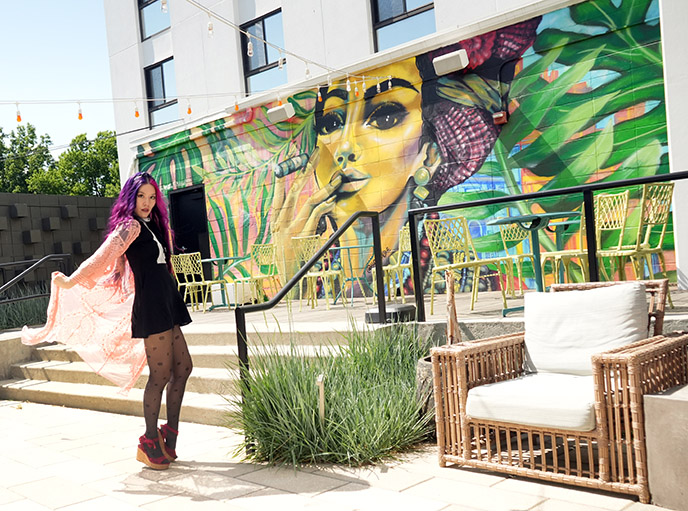
I’ll admit it feels good to be back in my element this summer: traveling, seeing friends, and experiencing creative food and art wherever I go.
I got to do all of the above during my colorful stay at Studio Allston Hotel in Boston, MA — as well as while dining outdoors at The Hourly Oyster House in nearby Cambridge!

Located in the Allston neighborhood of Boston (west of downtown / the harbor), Studio Allston is a hotel and visual experience rolled into one. The property partnered with 22 local and national artists to fill the spaces with giant murals, modern furniture, and other funky decorative elements.

Each of the 117 guest rooms is filled with energetic art, but 10 of these are signature suites designed by a different artist. These luxurious rooms have themes that include gaming, runway chic, and cosmos / space.
I was thrilled to have the movie screening themed suite, which is set up with colorful Ligne Roset Togo couches, and a retro-style fridge for drinks and snacks!

The marvelous Studio Allston staff surprised me with wine, postcards, and eco-friendly boxed water in my room.
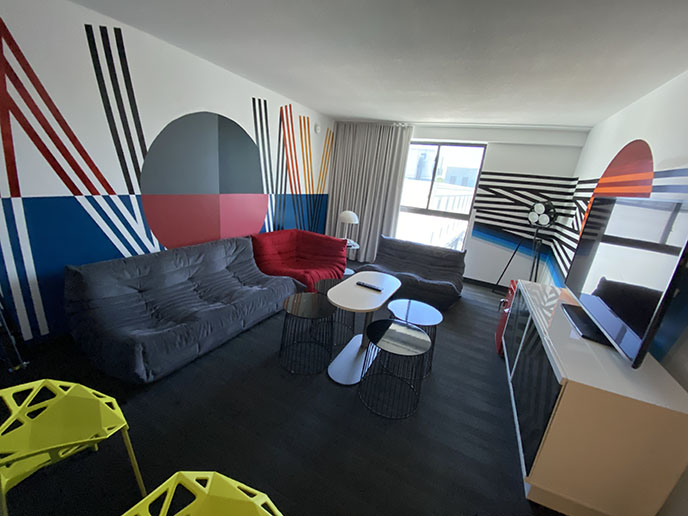
I couldn’t have imagined a cooler place to stay in: the “Reel Countdown Movie Suite” designed by Cyrille Conan. The 500+ square foot suite includes a king bedroom and separate living area, and industrial film lights that add to the theme.
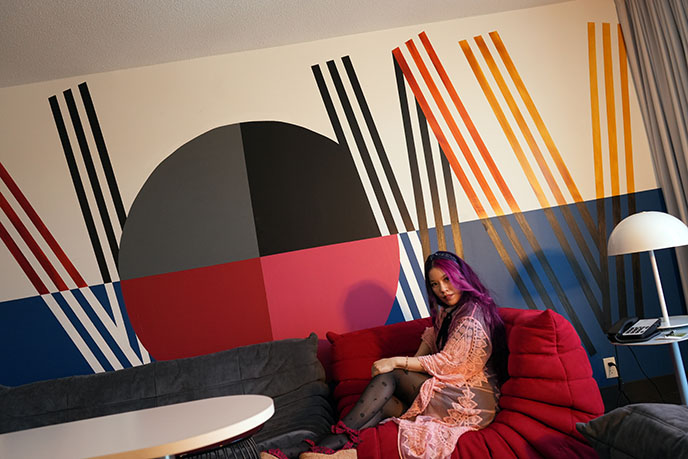
The room’s large-screen TV has tons of channels, or you can easily connect your device via Google Chromecast to stream shows.
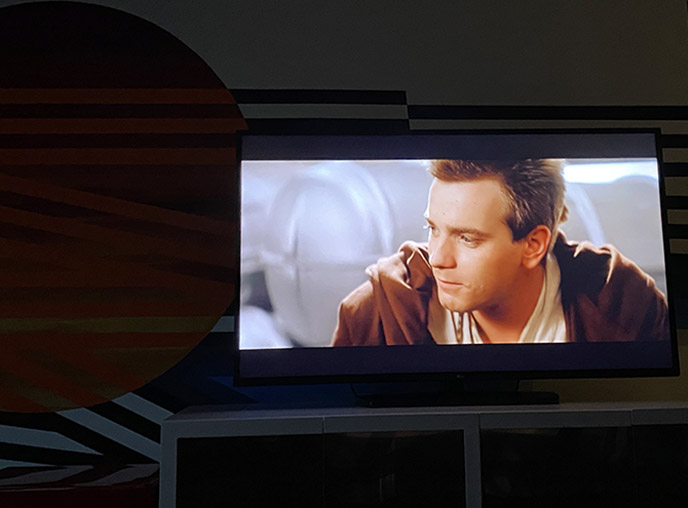
I got cozy in the corner seat, and dove into the first three episodes of Obi-Wan Kenobi on Disney+.

As you can see, the separate bedroom is also huge and filled with inspiration.
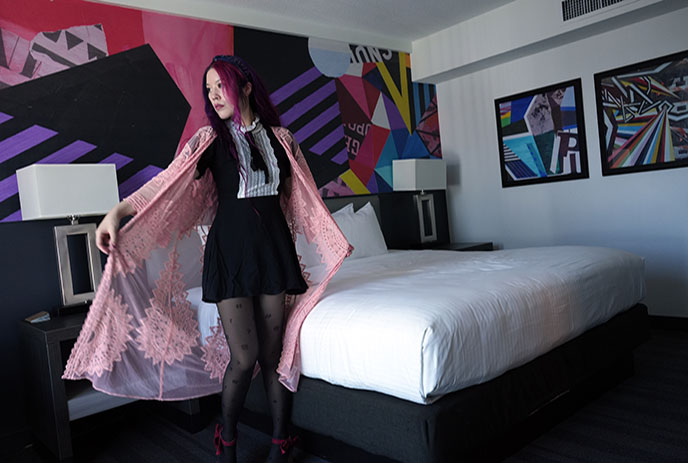
The “art head boards” add a lively touch to the modern amenities. My room at Studio Allston had everything I needed for a luxurious stay, including a full-sized bathtub.
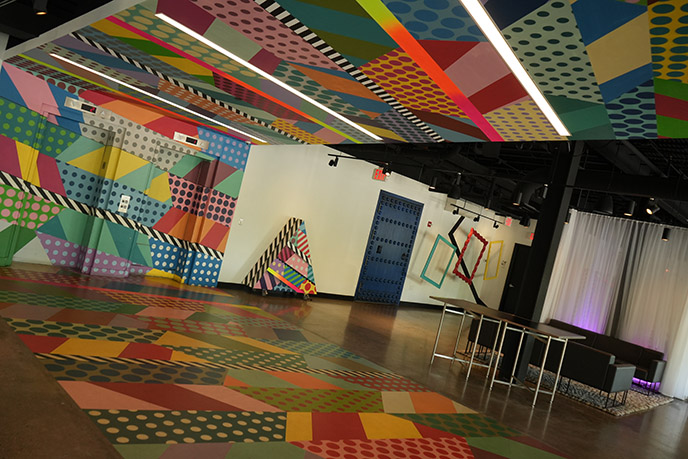
The floor-to-ceiling art immersion begins as soon as you enter Studio Allston’s lobby.
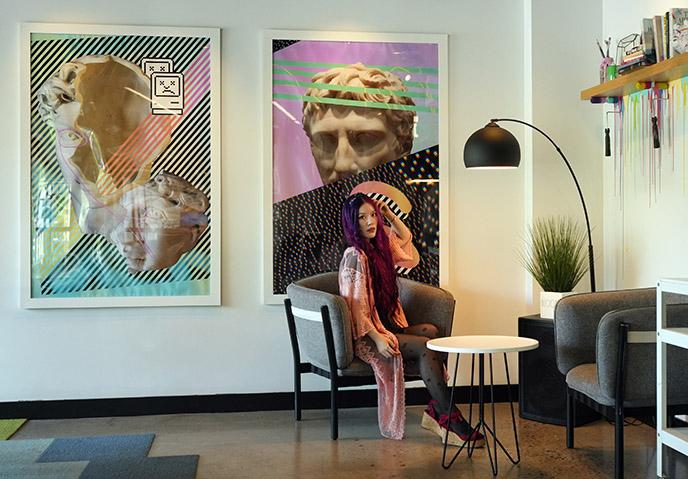
Like the rooms, the lobby is gargantuan (one of the benefits of staying outside the compact downtown area). I was into the vaporwave 90s pastel throwback vibe of this lounge area.
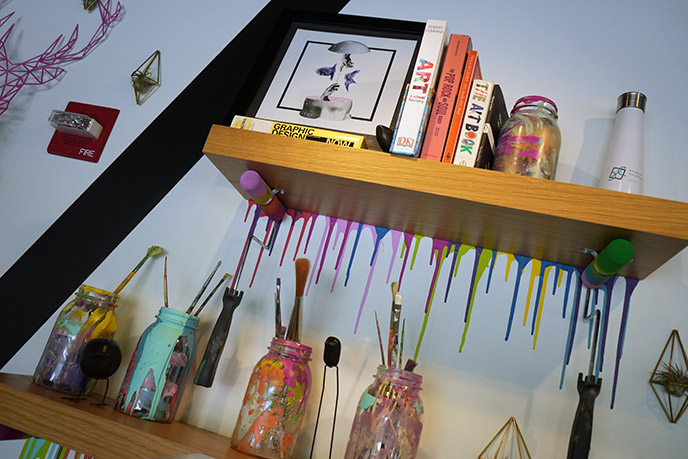
Boston’s edgy Allston neighborhood is filled with contemporary galleries and public art installations, much like this inventive hotel. Studio Allston is also right by Charles River (you can stroll across the bridge to the Harvard Cambridge district), and walking distance from Trader Joe’s (I went several times to stock up! Try the canned dolmades, oven-baked cheese bites, and hard kombucha).
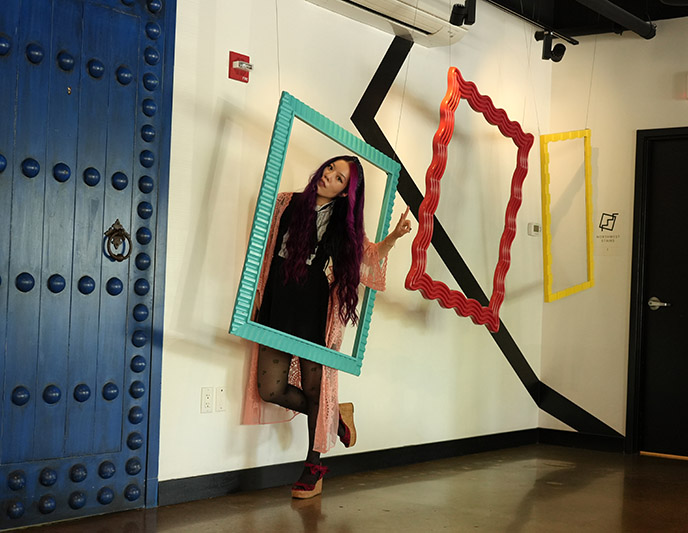
Studio Allston’s playful spaces encourage you to take part in the fun. There are Instagrammable spots such as these picture frames, and a ping pong table for impromptu games.
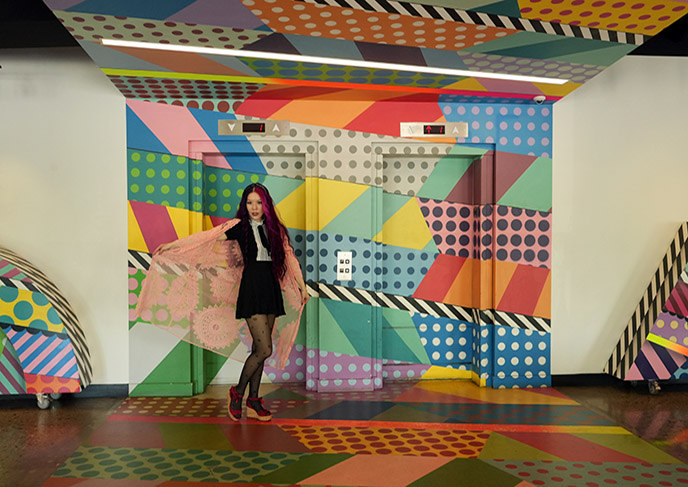
Now that’s a disco elevator if I’ve ever seen one.

No space is left un-glammed. Studio Allston lights up its elevator with pink neon, letters and numbers.
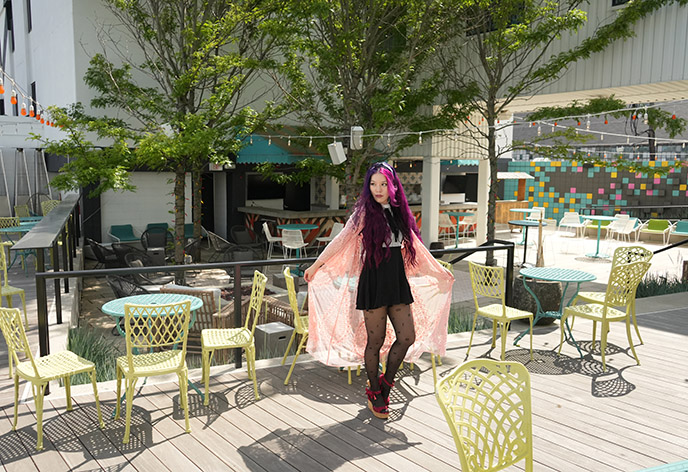
Every morning, Studio Allston serves free breakfast, which you can eat indoors or outside on the deck. There’s also a table of free coffee and tea available at all times for guests.

Studio Allston’s ground level Gallery Space also hosts rotating exhibits. At the time of my stay, there was a long hallway lined with photographer Jay Lamour’s flamboyant portraits.
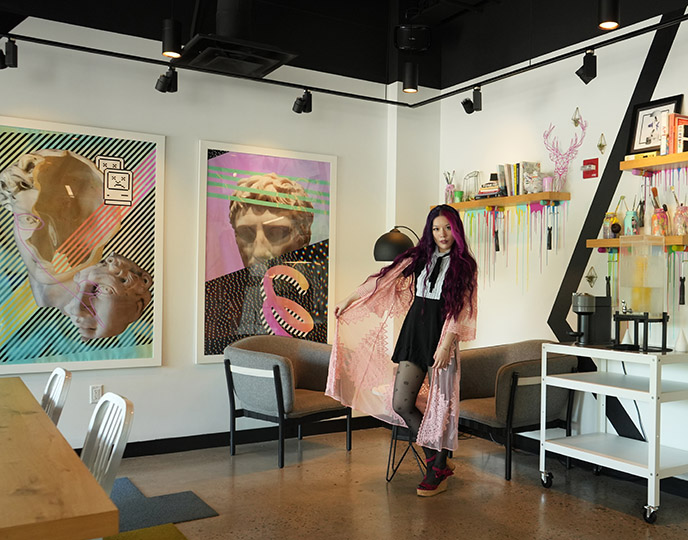
Can you tell that I felt inspired to #StayOutsideTheFrame, at Studio Allston?

Notice the painted van outside… that’s yet another art piece!
Cheers to Studio Allston Hotel (Boston, Massachusetts) for the hip stay. I especially dug the boutique hotel’s themed suites, groovy decor and location — and I think you would too.
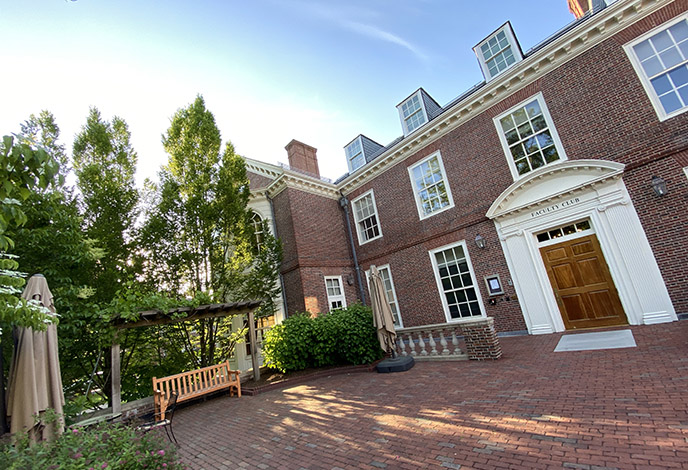
From Allston, you can take a quick Uber or walk across Charles Bridge to Cambridge, MA. I had the best time moseying around Harvard Square and taking in the ivy-and-brick atmosphere, such as at the Harvard Faculty Club. Stop for an iced tea at Tatte and pop into the Harvard Book Store, Leavitt & Peirce cigar and oddities shop, and Cardullo’s Gourmet Shoppe.

After a few hours of walking around Cambridge, MA, I was ready for dinner at The Hourly Oyster House in the heart of Harvard Square. The restaurant sits in a classic building and is named after the “hourlies,” or horse-drawn wagons that used to roll past its location on 15 Dunster Street.

The Hourly Oyster House invites diners to enjoy thoughtfully sourced and playfully prepared seafood and oysters from New England and beyond. The welcoming staff is terrific at explaining the daily catch and shellfish, which can include a tray of freshly-shucked oysters from Massachusetts, Maine, New Brunswick, and Prince Edward Island.

I was charmed by the old-school ambiance of The Hourly, including a long bar and stools where you can sit and choose oysters.
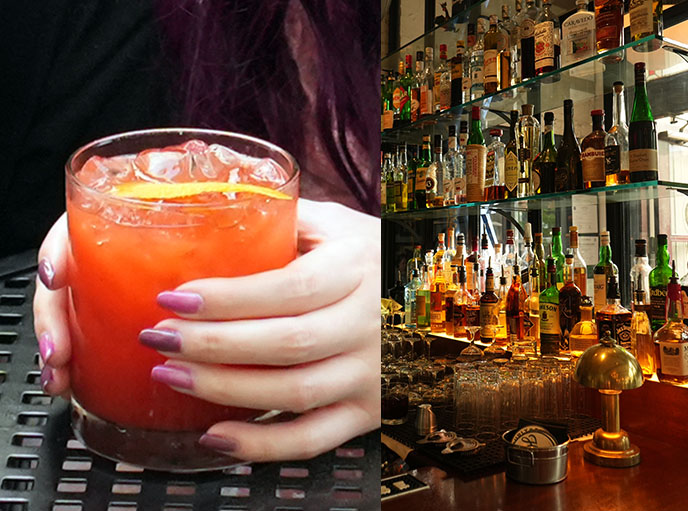
The old-school bar serves wine and craft cocktails based on traditional recipes, but with modern touches. I’m still savoring my blood orange negroni with gin, Campari and vermouth — and the “Interrobang” with bourbon, apricot, and honey.
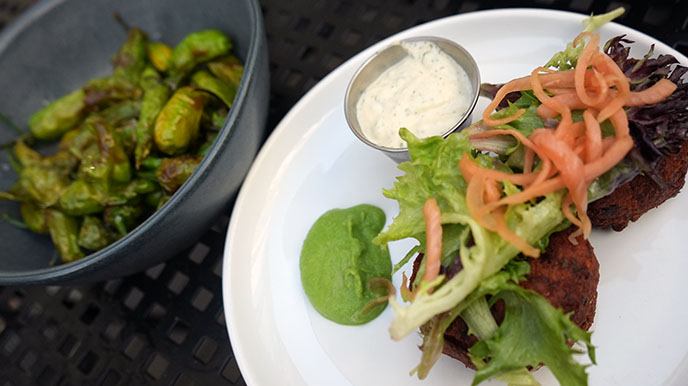
I love to eat fish and seafood, and had a hard time choosing from the list of tantalizing appetizers! I pondered the calamari, lobster bisque, clam chowder, grilled octopus, tuna or fluke crudo… In the end, we went with the blistered shishito peppers, and New England cod cakes (with pickled onion, greens, and remoulade).

When it came to the main courses, you couldn’t go wrong with any of the ocean options. Here’s the grilled swordfish with arugula, fingerling potatoes, tomato conserva, and Parmesan. You can taste the high quality of each ingredient, and the fish’s subtle flavors.

The juicy scallops were perfectly seared and came with mushroom risotto, broccolini, parmesan, and lemon for tang. For dessert, go for the mango panna cotta with a superb passionfruit whipped cream.
The Hourly Oyster House is the place to be, if you’re a fish and seafood aficionado like me. Thank you to the staff for the friendly welcome and meal to remember.

And in case you’re wondering, my tote bag is from the Maje x Sailor Moon collection. My pink round oversized sunglasses are by Emilio Pucci. Find more Pucci eyewear below:
mura

 LA CARMINA
LA CARMINA






